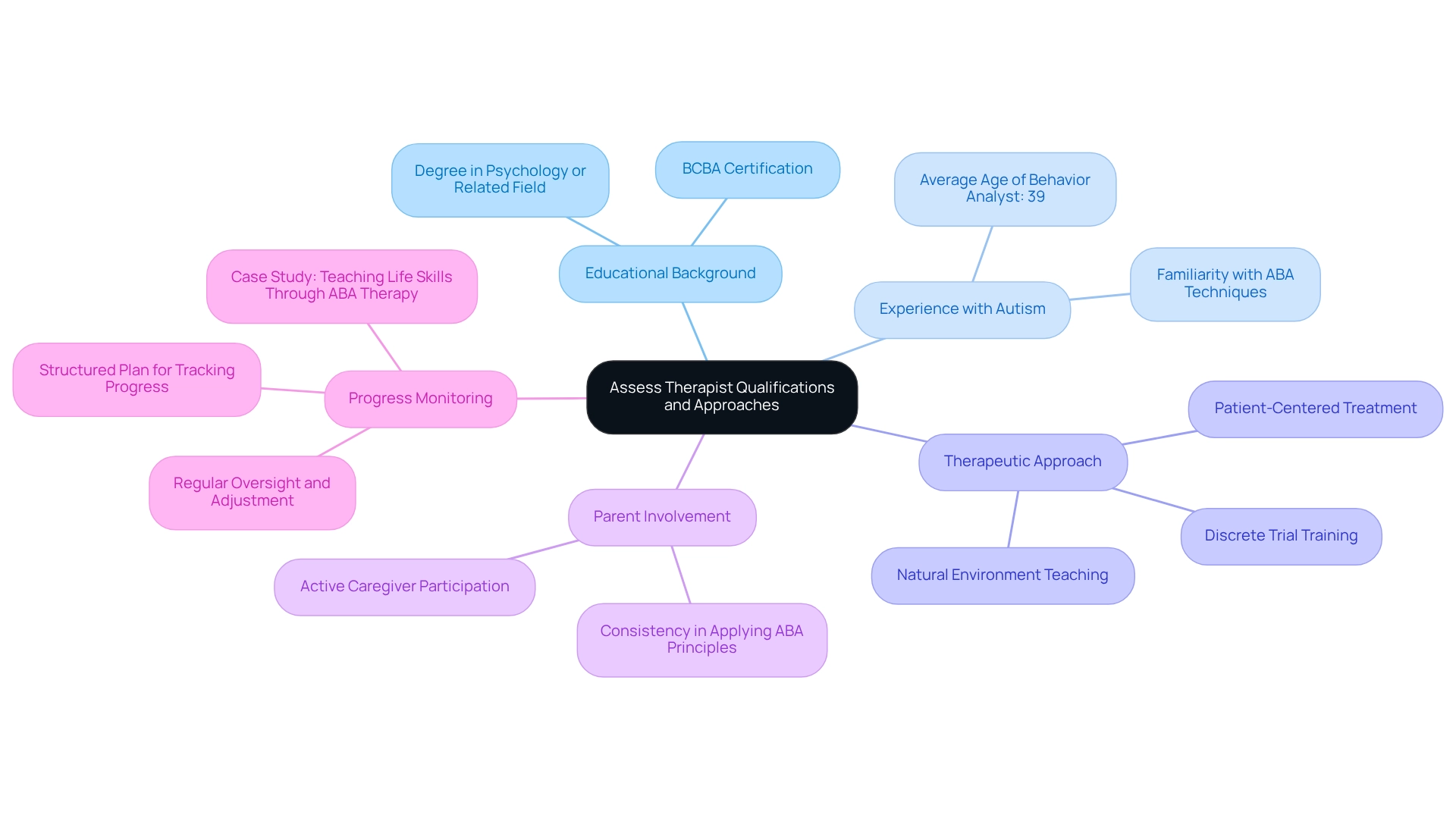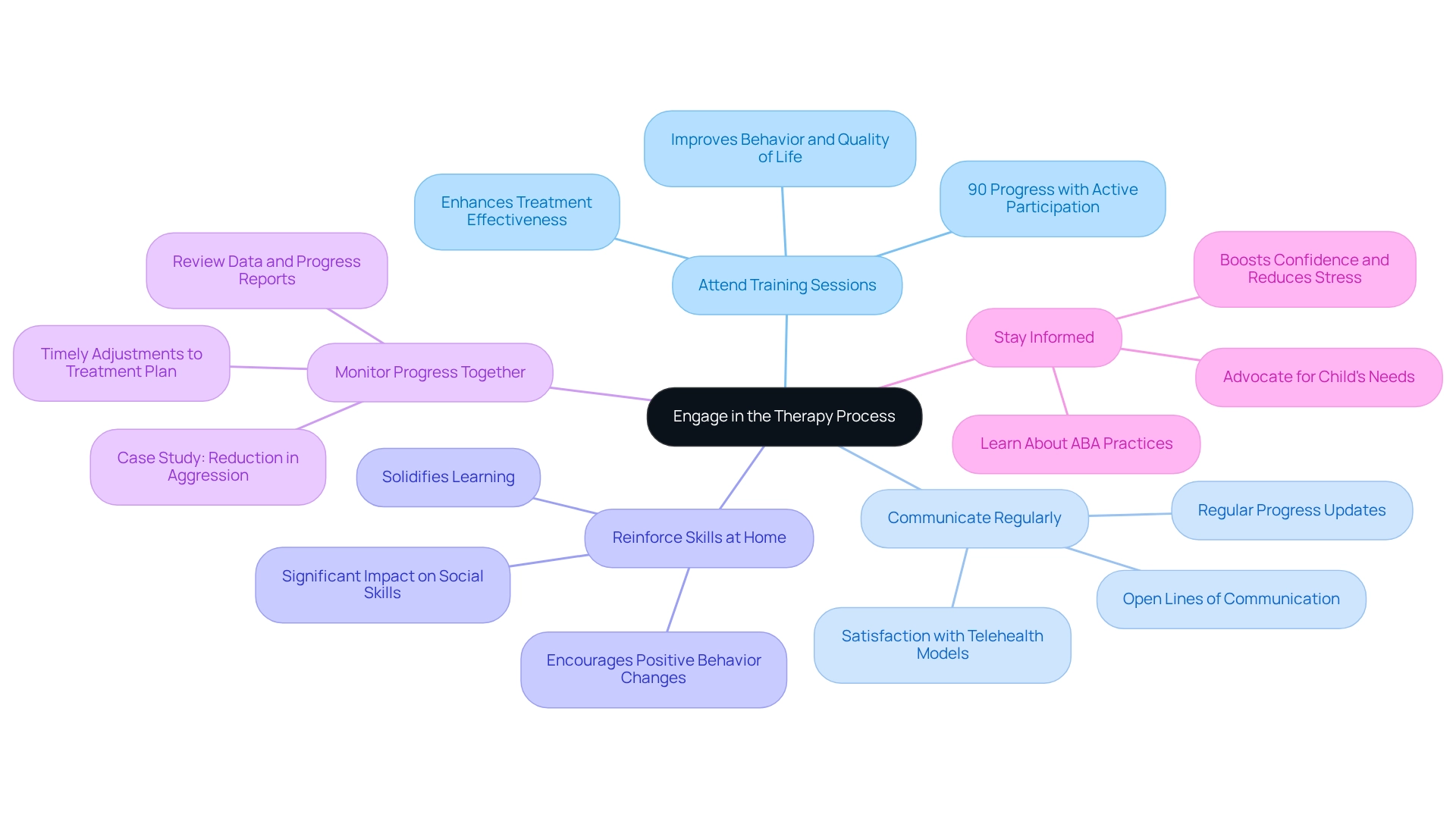This article highlights the essential steps parents should consider when hiring Applied Behavior Analysis (ABA) therapy providers for their child. It's crucial to research local providers and verify their qualifications. Engaging actively in the therapy process is key to ensuring effective and personalized treatment for children with autism. Research shows that ABA can significantly improve behavioral outcomes, and understanding this can really empower parents.
Navigating the world of ABA therapy can feel overwhelming, but you’re not alone! Many parents share similar experiences, and it’s important to connect with others who understand your journey. By taking the time to explore your options and ask questions, you can find the right support for your child.
Let’s explore this together! Remember, your involvement in the therapy process not only helps your child but also strengthens your bond as a family. We’re here to help you every step of the way!
When it comes to enhancing the lives of children with autism, Applied Behavior Analysis (ABA) therapy truly shines as a proven approach that has changed countless lives for the better. 🌟 By honing in on specific behaviors and skills, ABA therapy uses a data-driven method that tailors interventions to fit the unique needs of each child.
In this article, we’ll explore the core principles of ABA therapy, discuss how to evaluate local providers, and highlight the vital role parents play in the therapeutic process. Understanding these aspects is key for caregivers seeking effective support for their children as they navigate the complexities of autism and aim for meaningful progress. Let’s explore this together!
Applied Behavior Analysis (ABA) is a scientifically validated approach designed to improve specific behaviors and skills in individuals with autism. It’s all about understanding how learning works and how we can modify behaviors through effective reinforcement strategies. Let’s break down the core components of ABA:
A qualified behavior analyst crafts these individualized plans, setting measurable goals and using evidence-based strategies to promote positive behavior changes and skill acquisition. Continuous assessment and adjustment ensure that the treatment adapts to the young person's evolving needs.
Research shows that ABA intervention significantly enhances academic abilities and social behaviors in youth with autism. In fact, studies highlight that ABA therapy effectively improves academic skills, underscoring its importance in the educational journey of individuals with autism. Recent findings emphasize how tailored reinforcement strategies can lead to even better outcomes, showing that when interventions align with each student’s personal goals, the results are remarkable. For example, positive reinforcement techniques not only improve behaviors but also enrich overall learning experiences.
Real-world examples truly showcase the effectiveness of these strategies. Practitioners often use reinforcement to boost skills like communication and social interaction, leading to impressive improvements in young individuals' abilities. Plus, incorporating cutting-edge AI technology in ABA support can automate progress report creation, freeing up 50% more time for direct treatment. This efficiency allows practitioners to focus on engaging with youth, enhancing the overall impact of their efforts.
Continuous professional development for ABA practitioners is vital. As highlighted in the case study titled "Ongoing Professional Development in ABA Practice," this commitment to lifelong learning ensures that practitioners provide top-notch care and adapt to evolving methods in ABA.
Expert insights stress the importance of focusing on the individual needs of children rather than just their diagnostic labels. Ralph Moller notes, "By concentrating on the particular requirements of the person with autism, rather than solely the diagnostic label, treatment can be tailored to meet the individual's unique objectives and encourage advancement." By customizing therapy to meet specific goals, therapists can foster significant progress and empower families on their journey.
Moreover, caregiver education is crucial in supporting youth development through ABA. Informed caregivers can enhance support, make educated decisions, and improve behavioral outcomes, ultimately empowering them in their child’s journey. Understanding these foundational aspects of ABA helps parents appreciate the importance of ABA therapy hiring near me to find qualified providers who can effectively apply these strategies.
If you’re interested, Rori Care offers a complimentary consultation to discuss how ABA treatment can be tailored to meet your child's needs. Let’s explore this together!
When it comes to evaluating options for ABA therapy hiring near me, there are some important steps to consider.
First, let’s research providers together! You can use online directories like Autism Speaks or local health services to create a comprehensive list for ABA therapy hiring near me. Did you know the average salary of ABA professionals in Wyoming is $36,013? Understanding these financial aspects can help you get a sense of the market. Next, check out reviews and ratings. Platforms like Yelp or Google are great for exploring parent reviews, giving you insights into the experiences of other families with these providers. This feedback can really help you gauge the quality of care offered.
Now, let’s verify credentials. It’s crucial to confirm that the providers employ Board Certified Behavior Analysts (BCBAs) and qualified professionals. Take a moment to review their certifications and relevant experience—this ensures that your child receives quality care. The American Psychiatric Association emphasizes the importance of having qualified professionals in the ABA field.
Don’t forget to visit facilities! Arranging visits to potential providers allows you to observe the environment firsthand. You can ask questions about their therapeutic approaches and assess the overall atmosphere. With the current shortage of qualified ABA therapists, thorough research, including ABA therapy hiring near me, is key to finding the right fit for your child. It’s important to verify whether the provider accepts your insurance and inquire about available payment options that can help cover up to 100% of ABA treatment. Understanding these options can prevent any unforeseen expenses and ensure your child receives the essential support they need by considering ABA therapy hiring near me. By carefully assessing local providers, parents can pinpoint the best match for their child’s unique needs, ensuring they obtain the highest standard of care. Rori Care is dedicated to empowering caregivers with ABA principles and strategies, fostering child development through expertise and compassion, and making a positive impact on the lives of children with autism. Finding the right provider is a critical step in that journey. Let’s explore this together!
When evaluating therapist qualifications and therapeutic approaches, let’s consider some key factors that can help you make a great choice:
Furthermore, think about how this treatment might promote understanding and compassion among siblings of kids with autism. It offers a broader view of the effects of the intervention beyond just the individual. By empowering caregivers with ABA principles and strategies, they can make informed decisions that positively influence their child’s progress.
It's also important to note that ABA intervention is the only scientifically proven type of treatment for autism that is covered by insurance, making it a viable option for many families.
By thoroughly assessing these factors, you can select a therapist who is not only qualified but also equipped to effectively support your child's development. Let’s explore this together!

To effectively participate in the counseling process, parents should:
By actively participating in the treatment process, parents can create a nurturing environment that supports their child's growth and development. Implementing these strategies not only enhances the effectiveness of ABA therapy but also encourages parents to actively seek aba therapy hiring near me to be proactive contributors in their child's journey. The behavior care engine updates intervention and skill acquisition plans after each session based on achieved progress, ensuring that treatment remains adaptive and responsive to the child's needs.

Applied Behavior Analysis (ABA) therapy is a wonderful approach for children with autism, focusing on personalized interventions that cater to their unique needs. Let’s take a closer look at the core principles of ABA—like reinforcement, data collection, and individualized treatment plans—that have shown great success in boosting both academic and social skills.
Choosing the right ABA provider is so important for parents. By doing some thorough research, reading feedback, checking credentials, and visiting facilities, caregivers can find qualified professionals who truly understand their child's specific needs. It’s essential that these providers are committed to ongoing training and maintaining high standards in ABA practice, ensuring quality care for your little ones.
Parental involvement plays a crucial role in the success of ABA therapy. When parents actively participate in training sessions, keep communication open with therapists, reinforce skills at home, and monitor progress together, they can significantly enhance treatment outcomes. This engagement not only empowers families but also plays a key role in their child's development.
In summary, grasping the principles of ABA therapy, thoughtfully evaluating providers, and actively engaging in the therapeutic process are all vital for fostering meaningful progress in children with autism. By focusing on these elements, families can create a nurturing environment that supports growth and development. This ultimately leads to better outcomes and a brighter future for their children. Embracing this journey with knowledge and dedication can truly transform lives and empower families in their pursuit of effective support. Let’s explore this together!
What is Applied Behavior Analysis (ABA)?
ABA is a scientifically validated approach designed to improve specific behaviors and skills in individuals with autism by understanding how learning works and modifying behaviors through effective reinforcement strategies.
What role does reinforcement play in ABA?
Positive reinforcement is key in ABA; it encourages desired behaviors by rewarding children, motivating them to repeat those actions.
Why is data collection important in ABA?
Data collection is essential for tracking a young person's progress, allowing therapists to tailor interventions to meet each individual's unique needs and ensuring strategies remain effective and relevant.
How are treatment plans developed in ABA?
Individualized treatment plans are crafted by qualified behavior analysts, considering each young person's specific strengths and challenges, setting measurable goals, and using evidence-based strategies to promote positive behavior changes and skill acquisition.
How does ABA impact academic and social skills in youth with autism?
Research shows that ABA intervention significantly enhances academic abilities and social behaviors in youth with autism, leading to improved academic skills and better overall learning experiences.
Can you provide examples of how ABA strategies are applied?
Practitioners use reinforcement to boost skills such as communication and social interaction, leading to impressive improvements in young individuals' abilities.
How does technology enhance ABA practices?
Incorporating AI technology in ABA support can automate progress report creation, freeing up 50% more time for direct treatment, allowing practitioners to focus on engaging with youth.
Why is continuous professional development important for ABA practitioners?
Ongoing professional development ensures that practitioners provide top-notch care and adapt to evolving methods in ABA, enhancing their effectiveness.
What is the significance of focusing on individual needs in ABA?
Focusing on individual needs rather than just diagnostic labels allows treatment to be tailored to meet unique objectives, fostering significant progress and empowering families.
How can caregiver education support youth development through ABA?
Educated caregivers can enhance support, make informed decisions, and improve behavioral outcomes, ultimately empowering them in their child’s journey.
How can I learn more about ABA therapy for my child?
Rori Care offers a complimentary consultation to discuss how ABA treatment can be tailored to meet your child’s needs.